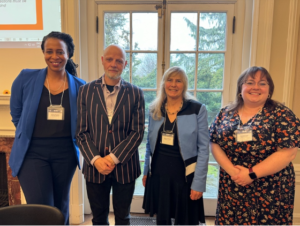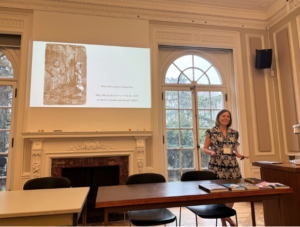Spring 2024 Newsletter
In this issue:
- President’s Message
- ACCUTE Panels of Interest for Victorianists
- Membership Reminder
President’s Message
Greetings fellow Victorianists!
My first year as VSAO president has flown by. Special thanks are due to the VSAO Executive members who helped with the transition: Nigel Finch and Taylor Tomko, both from Western, as our two new Members at Large; Brooke Cameron (Queen’s) and Hao Li (University of Toronto) as returning Members at Large; Jo Devereux (Western), as VSAO past president, David Latham (York University), as Treasurer, and Joti Bilkhu (York), as our new VSAO Secretary. Thank you all for your support and your work on this committee.
We have had a wonderful year, celebrating some remarkable accomplishments by members. This past November, Margo Beggs organized a book launch for the collection, Nineteenth-Century Women Illustrators and Cartoonists, edited by Jo Devereux. The evening’s event showcased Jo’s important work on Florence and Adelaide Claxton that is part of this collection, as well as research on Pamela Colman Smith and hand-coloured illustration by Lorraine Janzen Kooistra and Marion Tempest Grant. Margo spoke about her chapter on Amelia Frances Howard Gibbon’s ‘Illustrated Comic Alphabet.’ It was a lively evening, complete with beautiful archival materials that Lorraine brought in for us to enjoy.
Our annual spring conference (our 56th!), held at Glendon College on April 27, 2024, was a great success. We had an invigorating day full of papers that were organized around the central theme: “‘The Victorian World [as] a Space of Invention’: Returns to and Revisions of the Nineteenth-Century Past.” The morning panel featured papers by Marjorie Stone, from Dalhousie University, who spoke about “Aurora Leigh, ‘The Maiden Tribute of Modern Babylon,’ and Sex Trafficking Debates in the Nineteenth and Twenty-First Centuries.” Rachel Friars, a Doctoral Candidate in the Department of English at Queen’s University, gave a paper that was entitled, “‘No longer any I, only All’: Lesbian Gender Disruption in the Neo-Victorian Novel.” Charles Reeve, Professor of Visual and Critical Studies and Acting Dean of Arts & Science at OCAD University, spoke about “‘My strength, my comfort, my intense delight’: Elizabeth Murray’s Sixteen Years of an Artist’s Life in Morocco, Spain, and the Canary Islands.” Alisha R. Walters, Assistant Professor of 19th Century Literature and Culture at Penn State University, Abington College, delivered a paper about “Histories of Feeling and Empiricism: Inventing Victorian Racial Science.” The papers were all fascinating and showed the many approaches that can be taken when thinking back to the age of Victoria.

After a delicious lunch, we welcomed our first keynote of the day, Dennis Denisoff (of the Department of English, University of Tulsa, and one of our VSAO Past Presidents). Dennis works in environmental humanities and gender/sexuality/queer studies with an emphasis on Victorian and Modernist literature and culture.

Dennis spoke to us about some of his research on the 19th-century development of our modern notion of global environmentalism, in a paper that was entitled “Natural Kinship: Inventing Intimacies in Fin-de-siècle Eco-Writing.” Addressing the works of William Sharp and Michael Field, Dennis proposed that some authors of the Victorian period were not simply nature writers, but were envisioning their literary work as an affectionate act within their relationships throughout their organic ecology. He considered William Sharp’s, Michael Field’s, and contemporary Indigenous poet Tommy Pico’s entanglements with other species as practices of imaginative sympathy.

After the break, Natalie Neill, of the English Department at York University, delivered our second keynote address, ““Gothic (Re)Turns: Jane Eyre, Wuthering Heights, and Gothic Mash-Up.” Natalie, a specialist in the Gothic, satire and parody, women’s authorship in the Romantic Period, and transmedia adaptation, gave an animated talk that celebrated “the pleasures of re-reading.” The many transmedia adaptations that exist of Jane Eyre and Wuthering Heights speak to the versioning, sampling, and remixing of canonical Victorian texts in film, novel, and comics formats. We learned about “Frankenfictions” and revisions that circulated in the nineteenth century, throughout the twentieth, and into contemporary times, texts that employ mashup techniques that the Brontës themselves first modeled in their juvenilia and later fiction.
The conference concluded with our much anticipated sherry hour. Participants continued their conversations well after 5pm, as Maria and her wonderful staff cleaned up around us.
Many thanks to Glendon and to Maria Franco and her staff for their support of this event. Thanks are also due to York University’s LA&PS team for their financial assistance.
During the summer months, the executive will be discussing themes and keynote speakers for next year’s annual conference, which will be held on the 26th April 2025 (please save the date!). Suggestions for speakers may be forwarded to the president or to members of the executive.
Until next time,
Alison Halsall
Panels of Interest for Members
at the Upcoming 2024 Congress,
McGill University, June 12-21, 2024
Wednesday, June 12, 2024
10:30am-12:00pm
“The Coming Universal Wish Not to Live”: Victorians and the Future
– Joint Sponsored with Victorian Studies Association of Ontario (VSAO) BRONF 410
Chairs: Joanna Devereux, Western; Taylor Tomko, Western; Nigel Finch, Western
Erin Akerman, Brock – Nahneebahweequay and Indigenous Futures in the Nineteenth Century
Megan McLennan, Western – “Come hither, maids”: Amy Levy’s “Xantippe” and the Lesbian Continuum”
Amanda Paxton, Toronto Mississauga – Victorian Apocalypticism and the Predatory Mystagogy of Jean Vanier
1:30pm-3:00pm
Romanticism and Evil 1 – Joint Sponsored with North American Society for the Study of Romanticism (NASSR)
BRONF 046
Chairs: Adam Mohamed, Western; Liam Rockall, Western University
Devin Stroink, Western – Moral Inversion in Romantic Satire
Matthew Rowney, North Carolina at Charlotte – Bone Sugar: Recycling the Dead at Waterloo
Aiman Khan, Aligarh Muslim University – Nature and Heroic Echoes in Prometheus’ Profundity and Childe Harold’s Charms
Rajarshi Banerjee, Western – Deadly Opposites: Begging the Question of Byronic Evil across Cuverian Worlds
3:30pm-5:00pm
Romanticism and Evil 2 – Joint Sponsored with North American Society for the Study of Romanticism (NASSR)
BRONF 046
Chairs: Adam Mohamed, Western; Liam Rockall, Western
David Sigler, Calgary – Evil as a Form of Rule: Following in Mary Brunton’s Discipline
Sungkyung Cho, Brandeis – A No Longer Necessary Evil: Thomas Love Peacock and the Poet’s Amour-propre
Michelle Faubert, Manitoba – Floating Evil: The Literature of Slave-Ship Surgeons
Thursday, June 13, 2024
8:45am-10:15
“Japa-ing” to Freedom or/and Slavery: Modern Configurations of the Slavery Journey and Narrative
BRONF 151
Chairs: Chinelo Ezenwa, Western; Titi Aiyegbusi, Toronto
Belonwu Ezenwa, Western – “Freedom to and from Slavery”: Reflecting on Canada’s Migrant Labour Market through the lens of CBC’s First Person Migrant Stories
Chinelo Ezenwa, Western – My Country/My Slave Hold: Contemporary Nigeria “Master”-Slave Relationships and Transatlantic Slavery
Sheheryar Sheikh, Dalhousie – Goat-Shagged and Bereft: Accounts of Wage-Slavery in the Horrid Middle East
Therefore I Am: AI’s Impacts on Writing, Research, and Pedagogy
BRONF 310
Chair: Amanda Paxton, Toronto Mississauga
Emily Cann, Dalhousie – Being in the World of AI: Consciousness, Language, and the Irreplaceability of Non-AI-Supported Writing
Valentina Gaio, Queen’s; Chloe Stewart, Queen’s – The Word in the Place of the Idea: What Generative AI Reveals about the Essay
Amanda Paxton, Toronto Mississauga – AI and Thou: Relationality and Writing in the Age of Chatbots
Bill Kroeger, Toronto – Ghosts or Machines?: AI’s Implications for the Future of Writing in the Humanities
10:30am-12:00pm
ACCUTE KEYNOTE SPEAKER: Caroline Levine (Cornell)
BRONF 151
Studying Literature in the Climate Crisis, or a Tale of Three Pipelines
co-sponsored by RhetCanada, ESAC, and CAPS
1:30pm-3:00pm
MLA Report on English Majors’ Career Preparation and Outcomes
BRONF 151
Chair: Neta Gordon, Brock
Jacqueline Jenkins, Calgary Gordon Tapper, La Guardia
Speaking the World into Existence: Language Use in Speculative Fiction 1
BRONF 045
Chair: Kate Sheckler, Marianopolis
David Fleming, Marianopolis – Speculative Retrospection: Nature Writing and Human Rewilding in Climate Fiction
Jennifer Komorowski, TMU – Speaking the Apocalypse into Being: Indigenous Language Resurgence and Speculative Fiction
Kate Sheckler, Marianopolis –Ursula K. Le Guin, Consent, and Metaphor: Constructing Ursula K. Le Guin’s Worlds
3:30pm-5:00pm
Speaking the World into Existence: Language Use in Speculative Fiction 2
BRONF 045
Chair: Kate Sheckler, Marianopolis
Shamara Peart, Queen’s – Evil, Social Justice, and Communication in Akwaeme Emezi’s Pet
Alexander Morgan, Western – “it wouldn’t be accurate anyway”: Examining the Sapir-Whorf Hypothesis through the Critical Poetics of SF Worldbuilding
Is There Anybody in There? The Affective Impact of Generative AI on First-Year Writing Instructors
BRONF 310
Chairs: Amanda Paxton, Toronto; Phoebe Kang, Toronto
Concetta Principe, Trent – Paranoia or Enjoyment: Hunting for Generative AI in Students’ Papers
Monique Kampherm, Toronto Mississauga – (Dis)Inviting AI into our Writing Classrooms Eric Lehman, Trent – Precarious Writing / Precarious Labour – The Affect of AI
Generated Writing on Part-Time Academic Instructors
Pedagogy
BRONF 046 Chair: TBA
Kristen Smith, York – (Re)Generating Education: Practical Methods for Harnessing the Power of GenAI for Optimal Course Planning
Patricia Cove, Dalhousie – Material Culture in a Literary Studies Classroom: Experimenting with a “Maker Project” for STEM Students
Sarah Banting, Mount Royal – Reading the MLA Teaching Volumes: What They Reveal about What Literary Studies Teaches
Tina Trigg, King’s – Trauma-Informed Classrooms of Transgression: Reading about Genocide
Friday, June 14, 2024
8:45am-10:15
On College: Committee for Professional Concerns – Board Sponsored Panel
BRONF 151
Chairs: Neta Gordon, Brock; Mark Kaethler, Medicine Hat
Ryan Cox, Keyano
Laura Davis, Red Deer David Fleming, Marianopolis Kate Sheckler, Marianopolis Julie Warkentin, Sheridan
Discourses of Science
BRONF 046 Chair: TBA
Victoria Abboud, Windsor – Erupting Faith: Lyell’s Principles of Geology and Theological Intervention
Shawn Hamm, MacEwan – Electricity, Elixirs, and Consequence; or, Unpacking the Fear of Science
Carolyn Eckert, Waterloo – Punctuated Ethos: Addressing Trust, Credibility and Expertise in Times of Crisis
10:30am-12:00pm
ACCUTE KEYNOTE SPEAKER: Erín Moure
BRONF 151
The Poem Is a Language-Place Where Thinking Trembles Vibrates
co-sponsored with ACQL and CCLA
Saturday, June 15, 2024
8:45-10:15:
Sustaining the Past, Predicting the Future – North American Victorian Studies Association (NAVSA)
BRONF 310
Chair: Jason Camlot, Concordia University
Brooke Cameron, Queen’s; Michaela Wipond, Queen’s – “I Always Speak to Dogs and Cats”: An ‘UnArchive’ of Victorian Animal Rights Literature for Children
Barbara Leckie, Carleton – Climate Comma: Between the Victorian Past and the Victorian Future
Rachelle Stinson, York – A Beleaguered Fortress: The Idea of a Women’s University
Spring is Membership Renewal Time!
As VSAO memberships run from 1 May to April 30, it is time to renew your membership dues. Please see the membership renewal form below.
MEMBERSHIP:
Membership is $15 for students and sessionals, and $25 for all others. Membership includes a reduced registration fee for the spring conference, notice for local meetings, voting privileges, and participation at the annual business meeting. Please mail a hard copy of this form with a cheque in the appropriate amount made out to the “Victorian Studies Association of Ontario” to: Alison Halsall, VSAO President, 234 Vanier College, York University, Toronto, ON M3J 1P3. If you have any questions, please contact Joti Bilkhu, VSAO Secretary, at joti.bilkhu14@gmail.com.
Name: ____________________________________________________
Address: ____________________________________________________ (Institutional, if possible)
____________________________________________________
____________________________________________________
Telephone: ______________ Email______________________
As a cost saving strategy, VSAO information is posted on our website regularly rather than being mailed out.
[ ] I enclose a cheque for $15 or $25 payable to the “Victorian Studies Association of Ontario.”
[ ] I enclose a cheque for $25 or $35 for Student / Standard Membership and Conference Registration.
[ ] I enclose a cheque for $60 for the Sustaining Membership and Conference Registration.
[ ] I am a student or sessional. I enclose a cheque for $15.
Previous VSAO Newsletters
Fall 2018
Spring 2018
September 2017
May 2017
September 2016
May 2016
September 2015
May 2015
September 2014
May 2014
September 2013
May 2013
September 2012
May 2012
September 2011
May 2011
September 2010
May 2010
September 2009
May 2009
September 2008
May 2008
September 2007
May 2007
September 2006
May 2006
